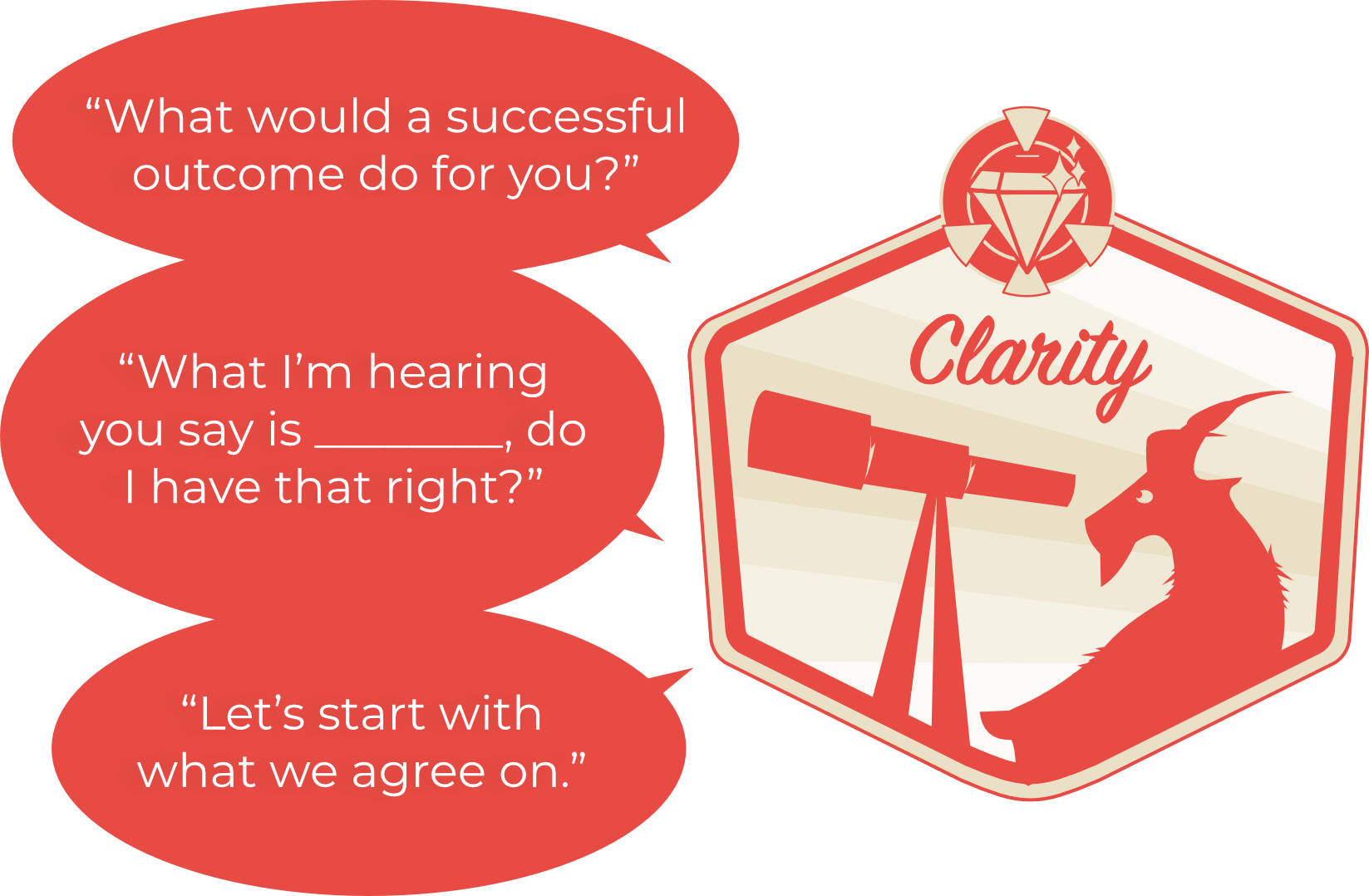Navigating Conflict
Navigating workplace conflict is no easy feat. It demands more than just a sense of awareness. It requires the right tools and words that transform conflict into constructive dialogue. This is where Karin Hurt and David Dye step in with their insightful book, Powerful Phrases for Dealing with Workplace Conflict: What to Say Next to De-Stress the Workday, Build Collaboration and Calm Difficult Customers. In this book, the co-founders of Let’s Grow Leaders provide a practical guide designed to arm professionals across various industries with the verbal tools needed to turn workplace confrontations into opportunities for growth and innovation.
Conflict is inevitable. Whenever passionate individuals converge with a common purpose, the stage is set for disputes. It’s human instinct. But here’s the twist: understanding how to manage these disagreements effectively can pave the way for improved workplace relations. It’s not about avoiding conflict but in harnessing its potential to foster deeper connections.
Both authors spoke to me about their latest work.
In the introduction, you link a Diaper Genie to handling conflict. It made me laugh, wince, and pay attention. Would you elaborate on this?
The Diaper Genie is our favorite metaphor for avoiding difficult conversations.
In case you readers are not familiar with these stink-containing contraptions, you take a stinky diaper, put it in the genie, give it a twist, and the plastic envelopes the diaper so tight it doesn’t stink. But of course, the stink is still there, which you know if you’ve ever had the pleasure of emptying one of those long, plastic-wrapped bundles of joy.
We’re big believers that with workplace conflict, if you can’t smell it, you can’t solve it. And while we think these contraptions are a great invention for parents and babies, metaphorical genies can derail your influence and impact and destroy trust.
When we asked respondents in our World Workplace Conflict and Collaboration Research (WWCCS) to think about a significant workplace conflict they’ve had in the past, and what advice they would give to their former selves if faced with this conflict again, they 21% said they would “talk about it,” or “talk about it sooner.”
In other words, they would have ditched the diaper genie.
You talk about the “Four Dimensions of Constructive Conflict”. Could you provide a real-world example of a conflict that was resolved by effectively applying all four dimensions?
Sure, first let’s tee up the four dimensions.
- Connection—Do we know one another as human beings?
- Clarity—Do we have a shared understanding of success?
- Curiosity—Are we genuinely interested in other perspectives and what’s possible?
- Commitment—Do we have a clear agreement?
And, now let’s apply them to a common workplace scenario. Dealing with a micro-managing boss.
Start with a “Connection” Powerful Phrase, where you connect to your manager at a human level and connect to your commitment to the work. For example, “I care about our success and I want to make sure I’m doing my part.”
Which sets you up for a Clarity Phrase, “I’ve noticed you… (insert the micro-managing behaviors you’ve observed here).

Sometimes, drawing attention to the facts is all it takes to help a stressed-out manager change their behavior—or to take time to explain what’s on their mind. For example, “I’ve noticed that you’ve asked me about this project five times in the last two hours.”
Then follow your “I noticed” phase with curiosity. Here are some examples:
“How can I help?”
“Is there something I’ve missed?”
“Do you have a concern about how…”
After you describe the objective facts, ask a question that creates space for both of you to learn and grow. These questions allow the manager to share genuine concerns, but also cause them to reflect on why they are micro-managing. If you can get that concern into the conversation, you can address it.
Then you can bring the conversation to closure with a “Commitment” Powerful Phrase.
Begin your response by acknowledging your manager’s concerns. Then move to how you will address them.
For example, “I’m hearing that the EVP is requesting frequent updates because the board is concerned about our progress. Can I make a commitment to brief you in writing on Wednesdays and in writing and verbally on Friday before lunch? We’ll be able to make faster progress if we’re not pullup on to provide frequent updates.
The GOAT phrases on page 27 are priceless. Would you share one or two of them and when they should be deployed?
Thank you! We have three GOAT (Greatest of All Time) Powerful Phrases or each dimension of productive conflict. Here are two of our favorites.
“What would a successful outcome do for you (Clarity)”
You may or may not agree on what success looks like, but gaining clarity around expectations can save a lot of time and wasted energy. If it turns out you both want the same thing, you can shift to a “how can we” conversation. “Great, it sounds like we both want something similar. So how can we make that happen?”
At the very least, this powerful question gives you insights into what the other person needs, and then of course opens the door for you to share your definition of success as well.
“I’m curious how this looks from your perspective (Curiosity).”
The beauty of this workplace conflict power phrase is that it can be useful at almost any point in the conversation. Variations include, “What’s your take on this situation?” “I’d love to hear your point of view on this.”
Of course, once you listen to their perspective, you set the stage to share yours.

Knowing the right time to “Say Goodbye” to conflict. Can you suggest when it might be more beneficial to persist or when you should let go?
Here are a few Powerful Phrases to ask yourself to know when it’s time to channel your inner Elsa and “Let it Go.”
“Have I tried?”
It’s so easy to fire up, have an imaginary conversation in your mind, let frustration take over, and dismiss the other person as toxic, hopeless or not worth your time. But in all that thinking and stewing you never actually had the conversation.
If you don’t try, nothing changes. So answer this one honestly and give yourself the gift of a better outcome—because the conflict improved or because now you have certainty over what you are facing.
“What do I gain or lose by quitting?”
Some situations described in our WWCCS felt more like a scene from a movie, where our hero or heroine reacts in one bold, spontaneous move, “well then I quit!” Most of the time, a wiser move is to take time and objectively consider the pros and cons. Talk with a good listener who can help you think this through.
“Is this conflict affecting other areas of my life?” If you’re sick, exhausted or crying in the paws of your labradoodle every night, it might be time to remove yourself from the toxic situation.”
I love the emphasis you make on the importance of clear expectations. How can managers ensure they are setting clear, achievable expectations but not by micromanaging?!
The number one secret to tough conversations is to avoid the need for them by setting clear expectations. One good conversation about expectations, can prevent fourteen “why didn’t you” conversations.
Anyone who has led groups for a period of time has dealt with internal conflicts on the team. What are the first steps a leader should take when they notice simmering conflicts?
Start with a look in the mirror to ensure you’ve set clear expectations, that they’re understood, and that you haven’t set up unnecessary competition that’s stirring up conflict.
When a team member comes to you frustrated with a co-worker, one of our favorite Powerful Phrases is “what do you want me to know?” This gets to the heart of the issue quickly. Another good one is, “how might I help here?” The power of this question is that it reveals whether the person just wants to vent or has a real problem. It also helps you understand how they see the problem.
One more, “Should the three (or more) of us talk together?”
This question is helpful in those situations where you suspect their focus is something other than solving the problem (like undermining a colleague or kissing up to you). For people who complain and want to dump their problems on you, it helps maintain mutual responsibility.
Who hasn’t had to deal with a boss who takes credit unfairly? What are some subtle yet effective ways to address this issue without causing a rift?
Unless there’s been a distinct pattern of credit stealing, we recommend you lean heavily on curiosity Powerful Phrases, share what you’ve observed, and show genuine interest in their perspective. You might continue this conversation by saying, “I love this kind of work, so I want to ensure people understand what I bring to the table for future opportunities like this.”
“I’m curious. Do you think _______ (boss, peer, or key stakeholder) understands my role in this project?”
How do you counter negative perceptions in the workplace such as if you are deemed too negative?
Dig a little deeper into the perceptions. We here from so many people who are surprised that they’re being perceived as negative, because they actually care deeply and are just trying to prevent problems and get it right.
A good place to start is how you respond to ideas.
“Wow, that’s interesting.”
Find something interesting, fun, or positive to about the idea and say that first. This connects you to the other person. Here are two more examples:
“I appreciate you thinking about…”
“That’s a creative way of looking at this.”
After affirming something positive about their idea, continue with something like:
“Here’s how we can make sure this succeeds.”
This Powerful Phrase is critical. You still share your challenges and concerns. But instead of stating them as problems, package them as solutions or opportunities.
Dealing with know-it-alls. Most of us can picture situations where we dealt with this one. Can you provide a phrase that effectively sets boundaries without escalating conflict?
“I’m sure your intentions are good. And sometimes, when you tell me what to do, it makes me feel you question my expertise.”
 Bullies in the workplace grabbed me. What immediate actions should be taken the first time bullying behavior is noticed?
Bullies in the workplace grabbed me. What immediate actions should be taken the first time bullying behavior is noticed?
Start with “that’s not okay.”
Saying “that’s not okay” sends a clear message that you won’t tolerate their bullying and that you expect them to treat you with respect. Sure, it’s scary to confront a meanie. But you have the right to a safe workplace. By speaking up and setting boundaries, you take a powerful step toward protecting yourself and a more positive work environment for everyone.
You mention “lazy, vague, and frustrating feedback”. What is a constructive way to solicit better quality feedback?
How you respond to poor feedback depends on what made it bad. Maybe you didn’t get any feedback at all. Maybe it feels unfair. Maybe you’re blindsided. In chapter 22, we go through a variety of these scenarios, which have one thing in common, ask for what you need.
For more information, see Powerful Phrases for Dealing with Workplace Conflict: What to Say Next to De-Stress the Workday, Build Collaboration and Calm Difficult Customers.
Image Credit: Jason Goodman

